General Tips for Exploring, and Camping with your Dog
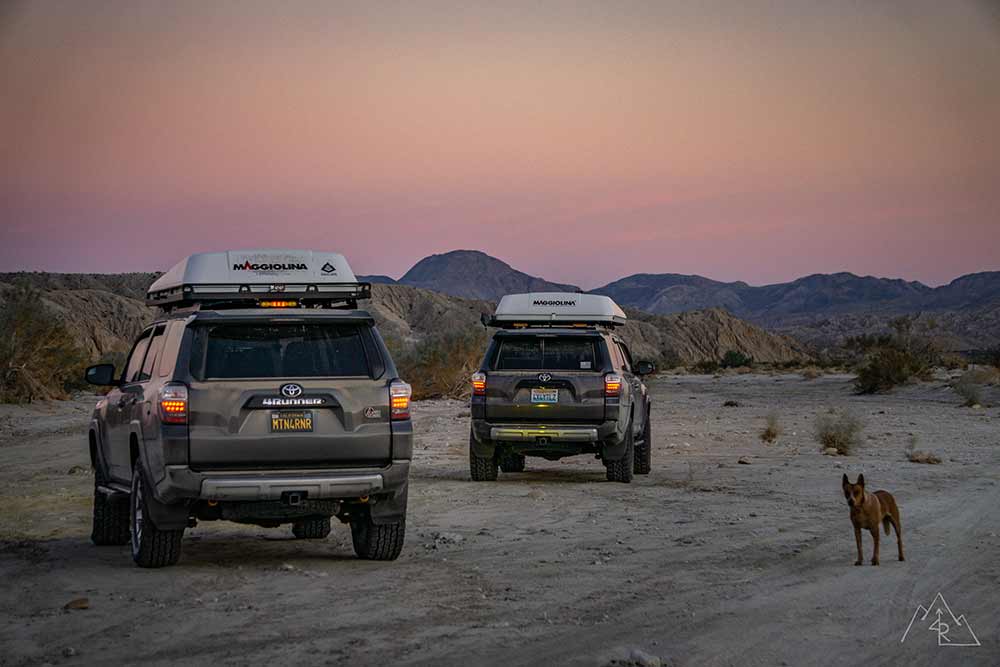
Dogs and adventures tend to mesh well together. Being outside, running around free from constraints, stopping to smell the air. It’s all something that we explorers yearn for in our day to day lives, and something our dogs do as well.
I know my dog Maeve enjoys every opportunity to breathe some mountain air. To bring our four-legged companions with us on our trips, there are some things to consider and prepare for.
To point you in the right direction, we’ll look into what you’ll need for your best camping K-9.
Planning your trip

Before heading out on your adventure, you’ll want to check to make sure that your location is dog-friendly. Thankfully many national forests and BLM lands are no restrictions pet-friendly, but many national parks and state parks have restrictions that range from leash requirements to all-out bans.
Don’t be caught in a pickle by not knowing whether or not your destination is dog-friendly by checking great resources like DogTrekker and BringFido.
Another less fun part of the planning process is deciding whether or not it’s best to bring your dog with you on your trip.
Temperature extremes, dangerous surroundings, and area restrictions can all be grounds for going without your dog as much of a bummer as it is.
Be sure to really think about how your plans will affect their happiness and well being before committing them to the trip. They can’t speak for themselves, so owner judgment is really important here.
Food and water
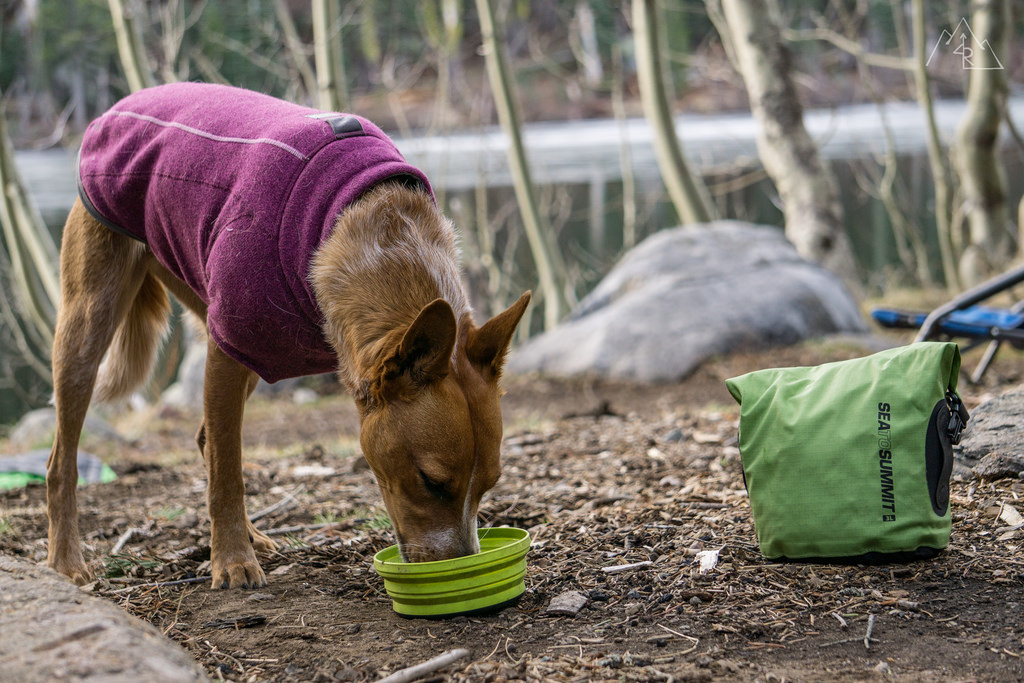
Just like at home, food and water are just as important for your pet in the great outdoors. How to transport those essentials can get tricky and how much you bring is entirely up to your pooch.
Food
For Maeve, we prepare for 2 cups per day of kibble and we always bring enough food for an extra day when we are going somewhere semi-remote, 2 days if it is very remote. This gives us some flexibility in case we decide to stay another day, or if things go pear-shaped.
To store her food we use a Sea to Summit Big River Dry Bag. It is waterproof, smell proof, and very tough to the rigors of travel. We like using it so much, that we bought a second one after the first one was destroyed by raccoons trying to get a quick bite.
Which leads me to the next tip: don’t leave your dog’s food where other animals can get it. Treat it the same as any other food in a campsite by either stashing it in the car, or in a bear-proof container.
Water
Bringing enough water to quench their thirst is important. They rely on water for hydration and cooling just as much as we do. Refer to the previous Portable Water Storage article for specifics on how much water to bring and how to bring it.
The biggest concern with water and dogs is knowing when it’s safe for them to drink water from natural sources as they might contain bacteria or toxins that can cause a dog to be ill.
Stay clear from small bodies of stagnant water, or larger bodies with murky / algae infested water. These sources can be more prone to other waterborne illnesses.
Medical preparedness
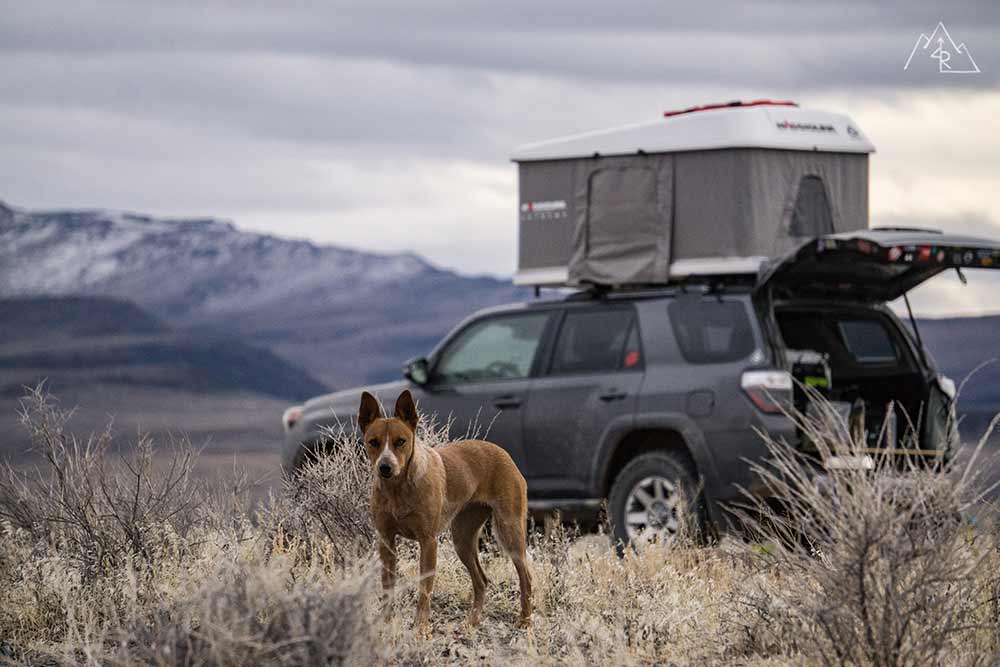
Say things go wrong when you’re out with your dog. From something minor to major, having the materials on-hand to help your pet in case of injury is very important. Thankfully there are companies who specialize in pre-configured animal first-aid kits.
I would recommend the Ready Dog Professional K9 First-Aid/Trauma Kit for its thorough coverage of different medical emergencies ranging from illness to general trauma. It comes with a skin staple which is a big plus, and a booklet covering first-aid basics for your dog and how to use the equipment in the kit.
Another very important thing to research before you go on a trip is where your closest vet clinic is at different points in the trip. Even if you use your first-aid kit to patch up your pooch, you’ll likely want to get to a professional opinion to make sure that everything is OK.
Looking up where your closest vet office is will make things much simpler when things need to happen quickly, and you may or may not have access to the internet or a cell signal to help you in the moment. Hours and minutes can make a huge difference when it counts most, so prepare thoroughly before hand.
Trail tip: Keep a digital copy of your dog’s medical records on your phone or cloud device to help the vet if you need to see one.
Secure transportation

Dogs travel in cars in many different ways. Some are passenger seat co-pilots. Others are backseat drivers with their tongue out the window.
I prefer the kennel method for Maeve for a few reasons, primarily safety. Dogs are just as vulnerable if not more so in the event of a car accident as any other person in the car. We have the ability to brace ourselves and most importantly be strapped in with engineered seatbelts.
Dogs, on the other hand, don’t have either of those benefits.
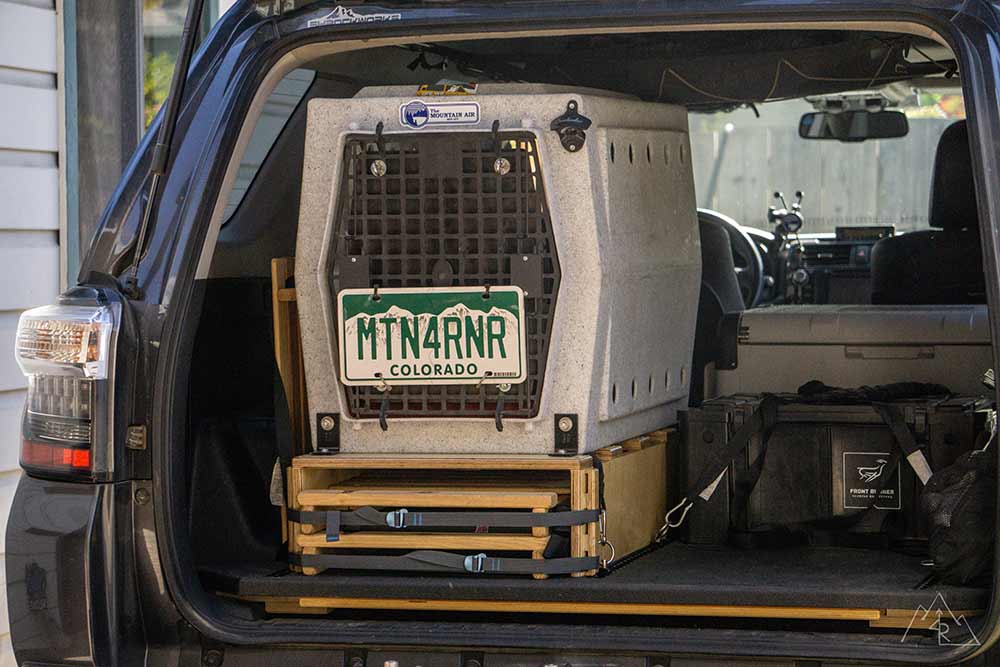
The best solution I have found through researching options is the use of a kennel. We use a Ruff Land Performance Kennel for Maeve because it’s one solid piece and extremely durable. Plus it comes in a double door option which is great for the 4Runner.
I mounted her kennel to a custom platform that is secured to the body using OEM threads. This makes her kennel about the safest place in the car for her. And as a bonus, I can pack the entire 4Runner with camping gear and she always has her space.
If a kennel isn’t in the cards for your layout, take a look at some other restraint options such as Ruff Wear’s Load Up Harness which uses the built-in seatbelts to restrain your pup in the event of an accident.
Another gadget I have for Maeve’s kennel to help track her well being is a Bluetooth temperature sensor from Sensor Push. It’s located on the outside of the kennel and has an impressive range outside the vehicle. It works well when I need to leave her in the 4Runner while I do something close by because I can check the temperature inside remotely.
You can also set alerts that will ping your phone if the temperature goes higher or lower than designated limits. It’s a simple way to make sure that your dog doesn’t get too hot or cold in the car.
Hot and cold

Being outdoors can subject us and our pets to extremes. No, I don’t mean just extreme views and experiences.
In this case, I am referring to extreme temperatures.
Camping can entail long cold nights and blazing hot days depending on where you are.
Bringing the appropriate gear for your pup can help them when it comes to staying comfortable.

For the heat, bringing plenty of water and providing appropriate shade is the key to keeping cool.
Maeve has been to Death Valley for an extended trip in the desert, and while the heat wasn’t at its average scorching temperatures I was able to keep water and shade plentiful to keep her content.
Heat and dry air also affect dog’s extremities, specifically their paws and nose.
Dog boots and moisturizing waxes can help keep their sensitive skin areas from drying out and cracking.
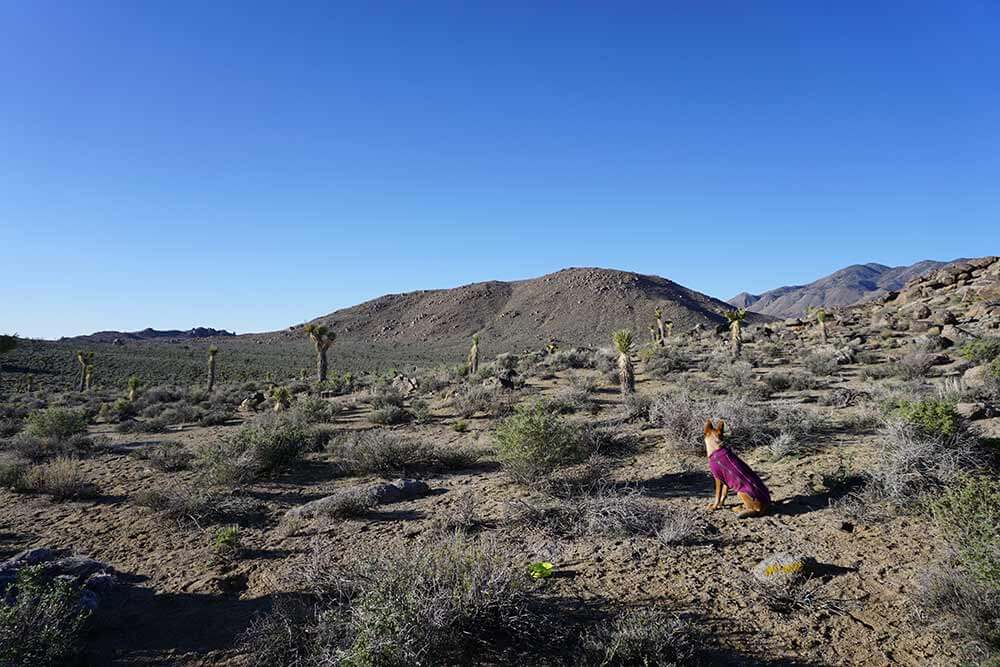
On the opposite side of the spectrum, cold weather requires different gear to keep your friend warm. Now some dogs are naturally built like a furnace and are able to withstand brutally cold temperatures without issue. But others need some assistance to keep their heat in.
When active try a dog specific jacket that can help keep their natural warmth in on the go. We have a few for different conditions, but the go-to is the Fernie Jacket from Ruff Wear because it’s light and warm for chilly mornings in camp.
And at the end of a day, a good dog bed or sleeping bag paired with a blanket can help them curl up next to the fire with everyone for an evening of fun.
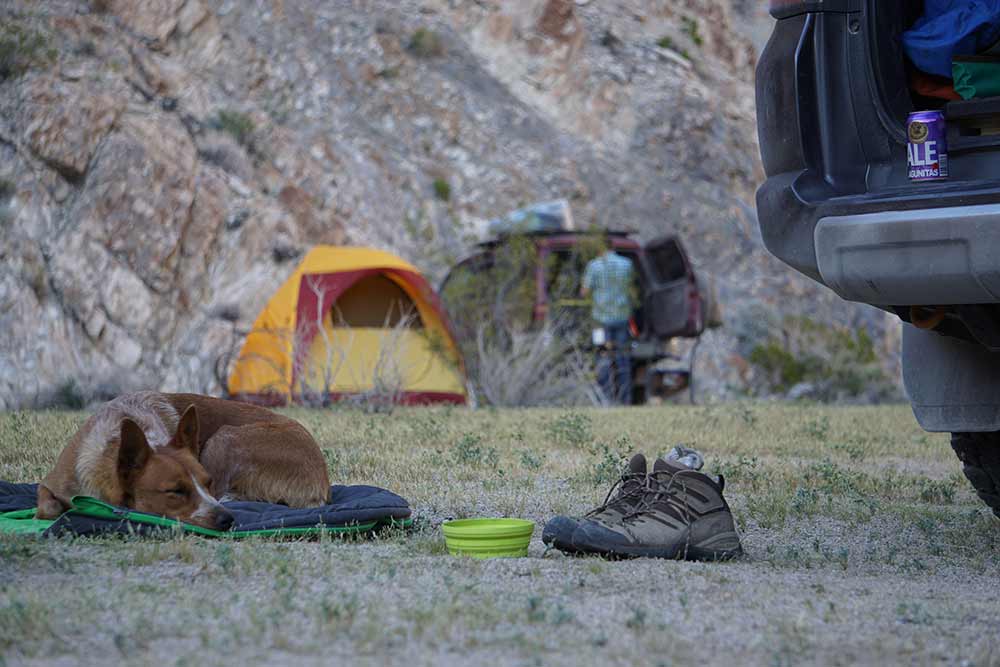
Trail tip: Dogs naturally produce a lot of outward heat. If you see your pup start to shiver, wrap them in some blankets or a jacket and make sure they’re insulated from below.
Around camp

We love having fun with the dog while we are on a camping trip doing the things that make her happiest. For play around camp, we have an arrangement of toys that range from balls to frisbees that keep Maeve on the move and are easy to clean/pack. Be sure to check your campsite for glass and debris before getting too playful.
Most campsites that we visit, even the remote ones, will have glass sitting on the ground or in abandoned fire rings. Pick up what you can, and leave it better for you and your pup to enjoy.
We are always careful and curious of any campground rules or fellow campers to make sure Maeve doesn’t encroach on someone else’s weekend outdoors. If your dogs like to wander around and you have others nearby, consider a long leash or rope to at least keep them confined to your camping area.
The worst thing you can do as a dog owner is break or bend the rules set forth by the area that you are in because it ultimately will have a negative effect on all dogs and their owners. Don’t be that guy.
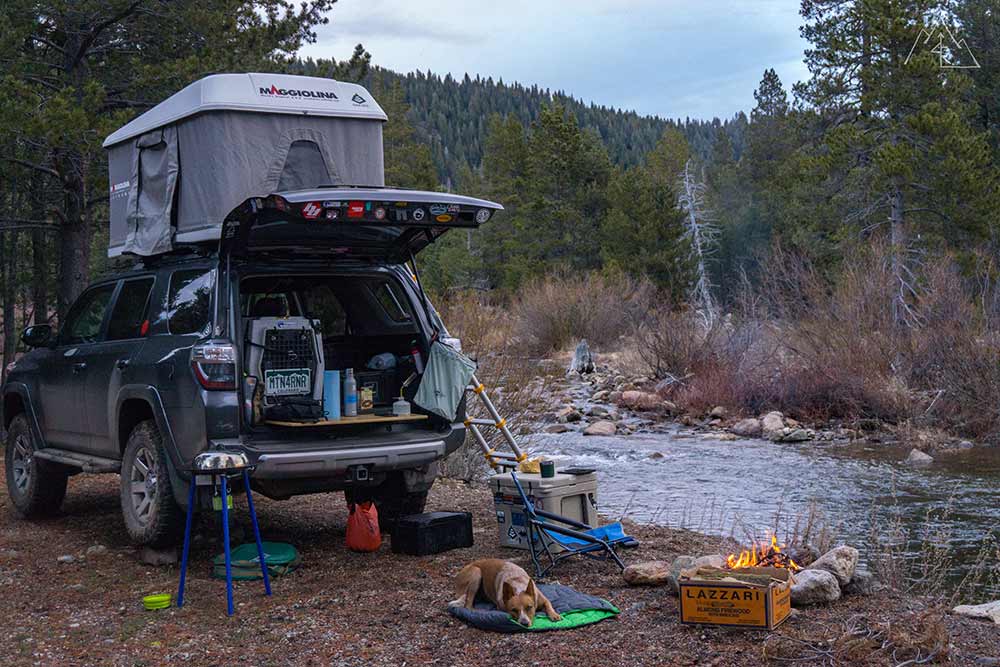
Go camping and you’re going to have a good time. Bring the dog and you’ll likely have a better time!
Just do what you can to prepare beforehand to fully enjoy the great outdoors with man’s best friend.

That kennel platform, though, is beautiful. Any specs or plans can share? Does it require removing back seat? 3 kids means I gotta work on some tetris and put the roof rack to work.
Great piece. Thank you.
You’re welcome! Glad you enjoyed!
Great article. When my friends got a dog and made a pen in the back, some of their gear was displaced to make room. Some was discarded since it wasn’t really needed. However, critical gear was relocated to my rig. This will happen amoung friends to ensure needed supplies are with you on trail runs.
Yep! Very true. It’s a challenge fitting the dog and all of the gear in our 4Runner. Removing the back seats helps a lot. I built a rear seat delete for a good friend of mine with 3 full size (60lb+) dogs and they are able to store things underneath them. But it’s a squeeze on longer trips for sure. That’s why we always invite a few Tacoma friends with plenty of bed space 🙂
i always take my dog abagail with me camping she is a great at letting me know when outer animals are coming close to the campsite so if needed i can grab my hand gun and asses the treat if they get to close i can fire off a warning shot to scare it away.
That’s a definite plus with having a dog with you! I have a friend with another cattle dog and he will let everything in the forest know that the campsite is his territory!
Great write up!
One thing I do is take a old climbing rope, 3 carabiners, a super long extendable / retracting leash (20 ft or so) and a harness with a D-ring on top. My malamute has “Squirrel!!” syndrome. I use the rope and two carabiners to span across two widely spaced open trees about 6 feet high and make it tight. The other carabiner slides on the rope and clips to the retracting leash. Then to the D-ring on the harness. This lets her roam around in a very large space and I don’t need to worry about “Squirrell!!! OMG!!”. Once in a while I do need to address her wrapping around a tree or two, but no biggie. I take it down at night for moose and such, the carabiners make this easy, wind it up and place it at the base of one of the trees.
You know, it’s funny because I have seen this before and I decided to leave it out of the article knowing that people typically have their own method of K9 restraining systems. But this is one of my favorite options for dogs that need to have their area restricted but still like to move around a lot. Thanks for sharing your method! // Max